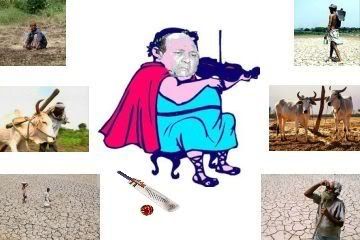
After the recent events coupled with experience of the last few years on the food front, the question in people’s minds is : For how long should the country suffer the continuance of a person who does not have any credibility left nor seems to be capable of meeting the challenges on the agriculture front, as the Agriculture Minister?
Over a year ago, India-awake highlighted in two articles, the inept handling of the Agriculture portfolio by Sharad Pawar, wannabe Prime Minister, and the resulting grim scenario as far as the food security of the nation is concerned. See articles here and here which bear reading. It was clearly visualized even then that due to lack of adequate attention and absence of purposeful policies for long term and sustainable improvements essential to keep feeding a growing population, the country was on its way to food scarcity and recurring cycles of imports as in the distant past. Even as the Minister kept on boasting about record production, Rs. 71000 crores had to be spent to bring succor to suffering farmers and a Government corporation imported under some scandalous transactions rotten wheat bringing back memories of PL-480 days of the distant past. Both had to be paid for with the taxes collected from the aam admi.
Last year when the country was reeling under high inflation, the all-knowing Finance Minister Chidambaram cited the “food crisis” as one of the reasons for the difficulties and the Congress Party was forced to issue a press statement calling for “better agricultural policies”. And yet towards the end of the previous Government’s tenure in April 2009, the clever Pawar managed to get Prime Minister Manmohan Singh to praise him with the latter saying that the agricultural growth rate during Pawar’s term had gone up to 3.5% from 1.8% during the NDA regime.
Sadly Pawar has managed to secure the same portfolio in the second term, ensuring continuing suffering for the people. Once again, the food scarcity, high prices and the lame excuses for the disastrous situation are being faced by the people in an uncanny repetition of what happened just last year. Going through the media reports of that time and now, only the dates and the statistics have changed. Qualitatively, the situation is far worse now. Till last year, only the producers i.e. the farmers were forced to commit suicide. This year, perhaps, even the consumers, the aam admi, may have to take the path if they cannot get their daily bread.
All that the Minister seems to have been doing all along is to claim credit for the high support prices the Government paid to the farmers and loan write-offs to the farmers which was essentially a burden on the people arising from government neglect. He thinks of everything only in terms of money and high support prices, subsidies and doles are his panacea. And, whenever there are problems related to availability or high prices of food articles, this master of sophistry is never short of clichéd excuses and song and dance blaming increase in consumption, failure of rains, unfavorable weather conditions, logistics problems, wastage of food grains, market intermediaries, hoarding, failure of the States, shortage of storage etc. many of which are the result of Government inaction. He even lamented that there was a huge wastage due to damages in government warehouses, implying that it was somehow not his responsibility. One gem on the cause of price rise: “prices had risen as the purchasing power of poor people had increased due to welfare schemes such as NREGA and, therefore, the demand had gone up tremendously.” He has also been inventing “new factors” like increase in income, climate change, high energy prices, globalization and urbanization! His latest googly in the Lok Sabha on 7th Aug. 2009 was: “There have been changes in the world, which are having an impact on India too.” With so many excuses available, it is so easy for him to use them in various combinations to explain even if people die of hunger.
When these factors work together to conspire against his efforts, what is the poor man to do other than focus on cricket or other such money-spinning ventures?
The Minister for Agriculture of the country is not there just to give out weather reports, reel out statistics to boast about record production and procurement, higher support prices and subsidies and feed misleading statements in place of food to the people while in the same breath, try to explain away shortages and rising prices.
In the last one month, the people are being fed with different projections of rains and production, none of which are reflected in the ground reality which is that the people are suffering even before the effect of the failing monsoon on the crops. On July 11, 2009 Pawar said: “there was nothing to worry about the availability of food grains in the country even though the monsoon situation was not normal.” Even later, on August 4, he informed Lok Sabha that the Centre had raised the food grains target to 238.12 million tonnes for the current year against 233.88 million tonnes in previous year. Everything positive that has been said about record production and procurement by Pawar is simply not matched by the prices which have been literally shooting up in a short time. He has also declared that the country has enough stocks of wheat and rice to last for 13 (or 30?) months. But after conveying a false sense of security on the food front for a long time, now he says that there is a problem and the people should expect high prices, directly stoking the high price fire. It is no use blaming hoarders or the monsoon.
The cases of two essential items of daily needs, namely, Tur Dal and Sugar, provide a clear insight into how the matters are being mishandled.
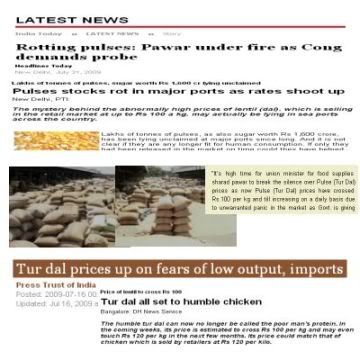
Tur Dal
In the case of Tur dal, the Government awoke from its slumber (self induced?) when practically overnight, the price mysteriously shot up to an unthinkable Rs. 100 per kg rising by 40% in one month, bringing untold miseries to the people. There is a fear that it may reach even Rs. 140 per kg. Indications about shortfall in production were available as early as January 2009 and in important growing areas like Karnataka, the production was expected to fall by as much as 40%. With rising demand for pulses where the country has been required to resort to regular imports even to meet normal demand, no serious efforts have been made to increase the production while the focus has been to increase the production of cereals and other grains. While talking about the situation Pawar, adept in sidetracking real issues gave in the Parliament the usual spiel known to everyone about domestic production being short, consumption growing, the country having to import, only a few countries having surplus in pulses, making efforts to produce more in the country etc. none of which could actually explain the specific question about the huge price increase in less than two months. And when the media reported about lakhs of tons of pulses lying at the ports even as the prices shot up, the Minister made a deliberate carefully drafted statement in the Parliament, that whatever quantity was procured by the government agencies was “not rotting” and also got the Pulse Importers Association to issue a denial which actually confirmed that “an estimated 3.7 lakh tonnes of pulses were currently lying at various ports and at port-towns and are in the process of being distributed to end-users in the hinterland”. Huge stocks lying at the ports were supposedly “in the process of being distributed” which ‘process’ can take an indefinite period of time. The seriousness of the situation was confirmed when the Government recently gave a belated ultimatum to the importers to lift the stocks in a certain time. According to one report, the price of Tur dal was Rs. 34 at the time of elections and has only since been rising continuously to touch the level of Rs. 102 in less than two months. There are many who think that the timing of the price rise tells its own story. It is also significant that the price increased even before the real situation of the monsoon was visualized.
Over a year ago, India-awake highlighted in two articles, the inept handling of the Agriculture portfolio by Sharad Pawar, wannabe Prime Minister, and the resulting grim scenario as far as the food security of the nation is concerned. See articles here and here which bear reading. It was clearly visualized even then that due to lack of adequate attention and absence of purposeful policies for long term and sustainable improvements essential to keep feeding a growing population, the country was on its way to food scarcity and recurring cycles of imports as in the distant past. Even as the Minister kept on boasting about record production, Rs. 71000 crores had to be spent to bring succor to suffering farmers and a Government corporation imported under some scandalous transactions rotten wheat bringing back memories of PL-480 days of the distant past. Both had to be paid for with the taxes collected from the aam admi.
Last year when the country was reeling under high inflation, the all-knowing Finance Minister Chidambaram cited the “food crisis” as one of the reasons for the difficulties and the Congress Party was forced to issue a press statement calling for “better agricultural policies”. And yet towards the end of the previous Government’s tenure in April 2009, the clever Pawar managed to get Prime Minister Manmohan Singh to praise him with the latter saying that the agricultural growth rate during Pawar’s term had gone up to 3.5% from 1.8% during the NDA regime.
Sadly Pawar has managed to secure the same portfolio in the second term, ensuring continuing suffering for the people. Once again, the food scarcity, high prices and the lame excuses for the disastrous situation are being faced by the people in an uncanny repetition of what happened just last year. Going through the media reports of that time and now, only the dates and the statistics have changed. Qualitatively, the situation is far worse now. Till last year, only the producers i.e. the farmers were forced to commit suicide. This year, perhaps, even the consumers, the aam admi, may have to take the path if they cannot get their daily bread.
All that the Minister seems to have been doing all along is to claim credit for the high support prices the Government paid to the farmers and loan write-offs to the farmers which was essentially a burden on the people arising from government neglect. He thinks of everything only in terms of money and high support prices, subsidies and doles are his panacea. And, whenever there are problems related to availability or high prices of food articles, this master of sophistry is never short of clichéd excuses and song and dance blaming increase in consumption, failure of rains, unfavorable weather conditions, logistics problems, wastage of food grains, market intermediaries, hoarding, failure of the States, shortage of storage etc. many of which are the result of Government inaction. He even lamented that there was a huge wastage due to damages in government warehouses, implying that it was somehow not his responsibility. One gem on the cause of price rise: “prices had risen as the purchasing power of poor people had increased due to welfare schemes such as NREGA and, therefore, the demand had gone up tremendously.” He has also been inventing “new factors” like increase in income, climate change, high energy prices, globalization and urbanization! His latest googly in the Lok Sabha on 7th Aug. 2009 was: “There have been changes in the world, which are having an impact on India too.” With so many excuses available, it is so easy for him to use them in various combinations to explain even if people die of hunger.
When these factors work together to conspire against his efforts, what is the poor man to do other than focus on cricket or other such money-spinning ventures?
The Minister for Agriculture of the country is not there just to give out weather reports, reel out statistics to boast about record production and procurement, higher support prices and subsidies and feed misleading statements in place of food to the people while in the same breath, try to explain away shortages and rising prices.
In the last one month, the people are being fed with different projections of rains and production, none of which are reflected in the ground reality which is that the people are suffering even before the effect of the failing monsoon on the crops. On July 11, 2009 Pawar said: “there was nothing to worry about the availability of food grains in the country even though the monsoon situation was not normal.” Even later, on August 4, he informed Lok Sabha that the Centre had raised the food grains target to 238.12 million tonnes for the current year against 233.88 million tonnes in previous year. Everything positive that has been said about record production and procurement by Pawar is simply not matched by the prices which have been literally shooting up in a short time. He has also declared that the country has enough stocks of wheat and rice to last for 13 (or 30?) months. But after conveying a false sense of security on the food front for a long time, now he says that there is a problem and the people should expect high prices, directly stoking the high price fire. It is no use blaming hoarders or the monsoon.
The cases of two essential items of daily needs, namely, Tur Dal and Sugar, provide a clear insight into how the matters are being mishandled.

Tur Dal
In the case of Tur dal, the Government awoke from its slumber (self induced?) when practically overnight, the price mysteriously shot up to an unthinkable Rs. 100 per kg rising by 40% in one month, bringing untold miseries to the people. There is a fear that it may reach even Rs. 140 per kg. Indications about shortfall in production were available as early as January 2009 and in important growing areas like Karnataka, the production was expected to fall by as much as 40%. With rising demand for pulses where the country has been required to resort to regular imports even to meet normal demand, no serious efforts have been made to increase the production while the focus has been to increase the production of cereals and other grains. While talking about the situation Pawar, adept in sidetracking real issues gave in the Parliament the usual spiel known to everyone about domestic production being short, consumption growing, the country having to import, only a few countries having surplus in pulses, making efforts to produce more in the country etc. none of which could actually explain the specific question about the huge price increase in less than two months. And when the media reported about lakhs of tons of pulses lying at the ports even as the prices shot up, the Minister made a deliberate carefully drafted statement in the Parliament, that whatever quantity was procured by the government agencies was “not rotting” and also got the Pulse Importers Association to issue a denial which actually confirmed that “an estimated 3.7 lakh tonnes of pulses were currently lying at various ports and at port-towns and are in the process of being distributed to end-users in the hinterland”. Huge stocks lying at the ports were supposedly “in the process of being distributed” which ‘process’ can take an indefinite period of time. The seriousness of the situation was confirmed when the Government recently gave a belated ultimatum to the importers to lift the stocks in a certain time. According to one report, the price of Tur dal was Rs. 34 at the time of elections and has only since been rising continuously to touch the level of Rs. 102 in less than two months. There are many who think that the timing of the price rise tells its own story. It is also significant that the price increased even before the real situation of the monsoon was visualized.
The people, left to their own devices could respond in the only way possible: they have been forced to reduce their intake of this essential source of proteins. Some State governments are talking of distributing tur dal through PDS shops in a limited way but the people-at-large have no option but to pay the high price. The helpless Agriculture Minister, apart from talking of augmenting imports after the prices have reached these levels, is twiddling his thumbs allowing vested interests to rake in huge profits.
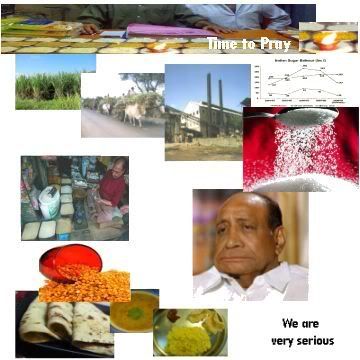
Sugar
The bitter case of sugar is more mystifying, and needs to be looked at, keeping in mind the fact that Pawar has long standing involvement with the sugar industry and as such there is prima facie a conflict of interest.
The economics and politics of sugar are determined by a complex web of government policies including import, export, MSP mechanism, levy and release mechanism, futures trading etc. which determine the prices that the consumer pays. Any wrong or untimely decision, deliberate or unintended, can result in the people having to pay dearly.
During 2007-2008 the sugarcane crop was 348 million tons creating a sugar surplus situation. In December 2007, Pawar himself asked the industry to reduce its heavy reliance on sugarcane cultivation owing to severe constraints on land, asking the industry to turn to alternative crops such as wheat, rice, cereals and oilseeds especially when the country would have to import them (all of these) in future. On 7th August, he told Lok Sabha: “Last year, when this Government had announced Rs. 1080 per quintal price for wheat, a sizeable section of the farming community, particularly in Uttar Pradesh, shifted from sugarcane to wheat.” (Lok sabha debates 7.8.2009). He is complaining now about what happened as a result of his own actions and advice! How did he handle the MSP mechanism? The table below is revealing.
The bitter case of sugar is more mystifying, and needs to be looked at, keeping in mind the fact that Pawar has long standing involvement with the sugar industry and as such there is prima facie a conflict of interest.
The economics and politics of sugar are determined by a complex web of government policies including import, export, MSP mechanism, levy and release mechanism, futures trading etc. which determine the prices that the consumer pays. Any wrong or untimely decision, deliberate or unintended, can result in the people having to pay dearly.
During 2007-2008 the sugarcane crop was 348 million tons creating a sugar surplus situation. In December 2007, Pawar himself asked the industry to reduce its heavy reliance on sugarcane cultivation owing to severe constraints on land, asking the industry to turn to alternative crops such as wheat, rice, cereals and oilseeds especially when the country would have to import them (all of these) in future. On 7th August, he told Lok Sabha: “Last year, when this Government had announced Rs. 1080 per quintal price for wheat, a sizeable section of the farming community, particularly in Uttar Pradesh, shifted from sugarcane to wheat.” (Lok sabha debates 7.8.2009). He is complaining now about what happened as a result of his own actions and advice! How did he handle the MSP mechanism? The table below is revealing.
Product
|
MSP 05-06
|
MSP 08-09
|
Paddy
|
570
|
850
|
Wheat
|
650
|
1080
|
Tur
|
1400
|
2000
|
Sugarcane
|
79.50
|
81.18
|
Note that the MSP for wheat has gone up by 66% whereas sugarcane is practically negligible. Was it not logical and anticipated that with such MSP changes acreage might move from one product to another and create shortage of one product and surplus of another? Surely, this could not have been an oversight. What may be the logic? Increase the MSP of other products first. This will inevitably result in acreage diversion from sugarcane and create shortages and panic. It may then be easier to bring about changes in sugarcane MSP as also overall sugar policy without appearing to show any favors and without questions being raised.
During 2007-2008, there was a surplus in sugar for a second year in succession. Unmindful of the cyclic nature of sugar cane production which could see a fall in production in the next year, he allowed sugar exports even by giving subsidies on exports after denying earlier that there would be subsidies. He was also pushing for allowing production of ethanol also from sugar cane juice apart from molasses and in favor of increasing the mandatory limit of ethanol blending in fuel from 5% to 10% ensuring either a rise in the sugar price or reduced availability.
Export and import policies are also being tinkered with, which somehow by accident seem to benefit the producers and traders. In Sept. 2008 he rejected an industry demand to allow duty free sugar imports saying there will not be requirement for imports.
When seen together with the prodding by Pawar to shift the land use and other actions like pursuing the higher-ethanol-from-sugar argument and rejecting import demand in Sept. 2008, allowing exports, do all these not look like pieces of a jigsaw puzzle created by a master?
On 31st July 2009, he made a statement in the Parliament, about the expected shortfall in sugar production shockingly stating at the same time that the lower production “has put pressure on sugar prices”. He could not be blamed for taking the Parliament in confidence on the situation. At the same time, it was an unmistakable cue for prices to shoot up locally as well as even internationally as he very well knows that India being a huge consumer, any such official pronouncement would have a big impact. The following chart shows what happened to international price of raw sugar in two weeks following 31st July (Friday).
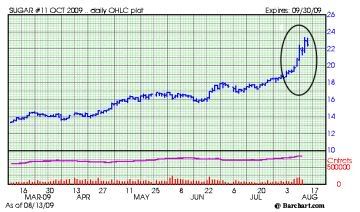
The price of white sugar also went up from $ 492 (31.7.09) to $ 577 (13.8.09). They have since reached a 28 year high. It is not difficult to guess that those in the know would have covered up good quantities of sugar from international markets just before the announcement, to make huge profits in a short time. And when the prices rose, the Minister started blaming speculators for spreading rumors. The following chart shows the actual sugar balance situation.
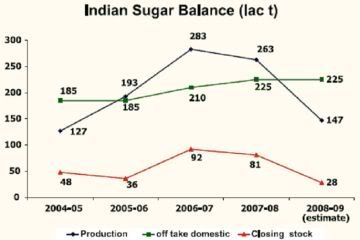
Another intriguing aspect of the situation is the response of the Indian Sugar Mills Association (ISMA). The website of ISMA was carrying a press statement in effect saying that the sugar supply was comfortable. In June 2009 too, they had made a statement to this effect.
Yet, suddenly, within just a few days after Pawar’s statement, the press statement was withdrawn completely from the website. Does this not tell a story?
He has been also less than transparent in letting the people know of the real situation. As late as 19th August, 2009, he merely said “Some shortfall in production of oilseeds and sugarcane is also expected” .
Earlier, on 31st July 2009 while listing various steps he told the Lok Sabha: “With these decisions, domestic availability of sugar will get augmented and sugar prices in the country will remain reasonable” A lay person is left wondering as to whether Government was not aware of the shortage which is claimed now, much before July 2009 as it was based on the crop from the earlier monsoon. Even a senior Congress functionary has blamed him for misrepresenting the sugar situation.
Now, to show that efforts are being made to augment the supply of sugar, he has entered into discussions with the sugar producers. He has proposed increase in the levy sugar target from 10% to 25% to augment availability with the Government. Several rounds of discussions have taken place and what is emerging is that the sugar industry not only wants a higher price for the levy sugar but at the same time also wants the government determined release mechanism for the non-levy quantity to be removed. The idea is clearly one: to get a higher price for levy portion and substantially free the controls on sugar whereby the industry can take maximum advantage in the open market. This actually seems to be the plan and the timing of the discussion is such that due to the approaching festive season, the Government will feel pressured to take a favorable decision just to avoid public ire.
Many people believe that the repeated meetings taking place with the sugar industry appear to be a scripted charade just for effect, with the objective of achieving substantial decontrol, a decision on which was deferred by the Cabinet earlier. Pawar has already revealed his mind as just last year he had called for abolition of levy system despite the cabinet deferring a decision to decontrol the sugar sector at that time. He had also said at that time: “We have got good stocks of about 11 million tonne as carry-over and we expect a good production. So this is the proper time when there is ample stock of sugar, one should take that decision,” Should such a major policy decision be taken considering just one-two years' supply balances? All the surplus somehow appears to have disappeared. It is just as well that the Government did not take a decision based on such short term considerations.
As rightly speculated by some in the Congress party, such a policy decision would leave the people at the mercy of sugar producers in times of such shortages. It is for the people to be aware of and guard against such perfidious plans.
The Prime Minister has already put the nation on notice that hard times can be expected while assuring that no one will go hungry. In whichever form the Government comes forward to help, it is the people who will pay for it and it is no credit to the Government.
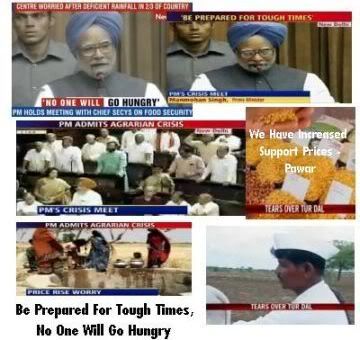 crisis calling
crisis calling
One thing is clear. This would-be* Prime Minister Pawar either does not know exactly what is going on or, more likely, knows exactly what he is doing. In either case, he hardly has the credibility left to handle such a crucial Ministry. It is now for the Prime Minister to oversee and monitor the decisions and actions of this Ministry closely to stop the Government being discredited further.
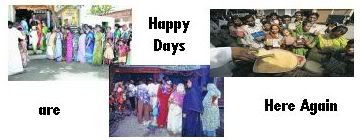
For the profiteers - happy days ... sona, hire-moti
While Sharad Pawar has done poorly in the Agriculture Ministry, his man Friday and coadjutant in the Civil Aviation, Praful Patel has done worse. But that is another tale.
* Would-be: Unfulfilled or frustrated in realizing an ambition
* Would-be: Unfulfilled or frustrated in realizing an ambition
Update: 19th Sept. 2009
The latest news article about rotting imported essentials in the ports puts paid to Sharad Pawar's bluff. ( see here)


